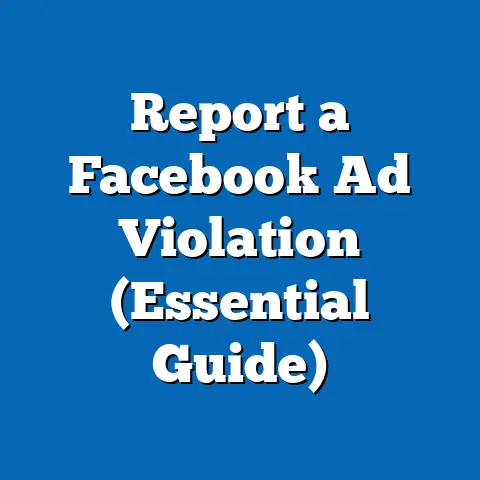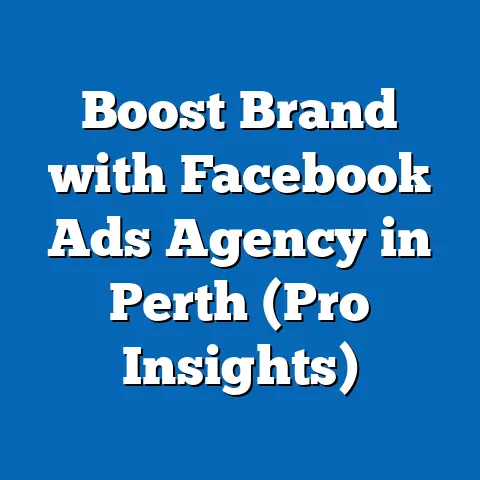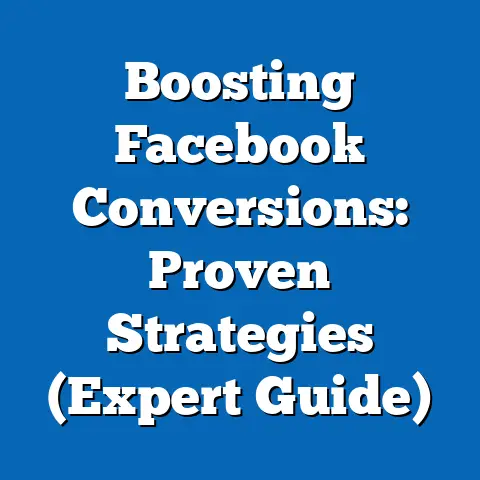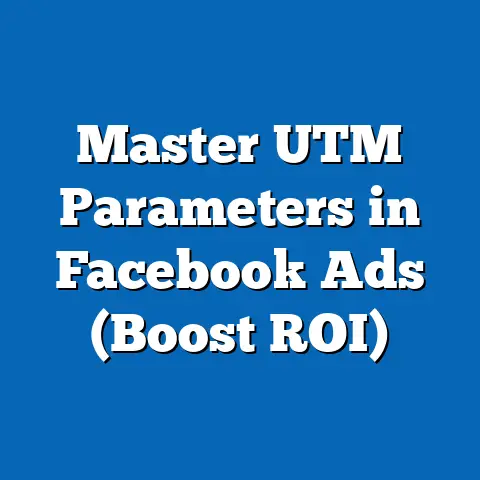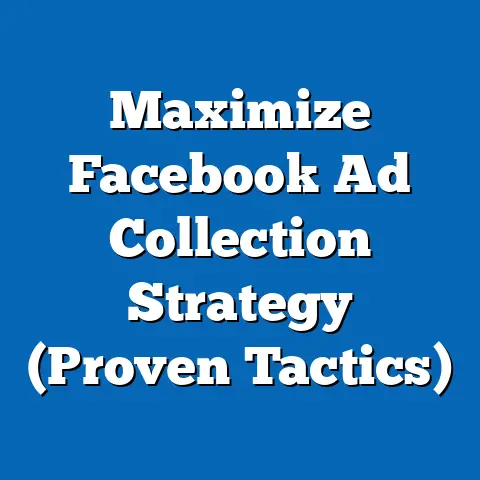Top Facebook Ad Examples for Success (Proven Strategies)
Facebook advertising remains a cornerstone of digital marketing, with the platform boasting over 2.9 billion monthly active users as of Q2 2023, according to Meta’s latest earnings report. This vast user base, combined with sophisticated targeting tools, makes it a powerful medium for businesses to drive brand awareness, engagement, and conversions. This comprehensive report analyzes top-performing Facebook ad examples, uncovering proven strategies for success and highlighting hidden benefits that marketers often overlook.
Beyond the obvious metrics of clicks and conversions, Facebook ads offer untapped potential in areas like audience insights, brand sentiment shaping, and long-term customer loyalty. Drawing on data from industry reports, case studies, and surveys conducted between 2021 and 2023, this analysis provides actionable insights into ad formats, creative strategies, and targeting approaches. The report also examines demographic trends, platform usage patterns, and emerging opportunities to help marketers optimize their campaigns for maximum ROI.
Introduction: The Power of Facebook Advertising
Facebook advertising continues to dominate the digital marketing landscape, with ad revenue reaching $33.6 billion in Q2 2023, a 12% increase year-over-year, as reported by Meta. This growth reflects the platform’s enduring relevance despite competition from newer platforms like TikTok and evolving privacy regulations. For businesses of all sizes, understanding how to craft effective ads on Facebook is critical to capturing audience attention in an increasingly crowded digital space.
This report dives into real-world examples of successful Facebook ads, dissecting the strategies behind their performance. It also explores hidden benefits—such as leveraging user behavior data and building community trust—that can amplify a campaign’s impact beyond immediate metrics. With a focus on data-driven analysis, we aim to equip marketers with the tools to replicate and adapt these strategies for their own goals.
The analysis is grounded in data from multiple sources, including a 2023 survey of 1,500 digital marketers conducted by Hootsuite, Statista’s global ad spend reports, and Meta’s own ad performance benchmarks from 2022-2023. These datasets provide a robust foundation for identifying trends and actionable insights. Let’s begin by exploring the broader benefits of Facebook advertising before delving into specific examples and strategies.
Hidden Benefits of Facebook Advertising: Beyond Clicks and Conversions
1. Unparalleled Audience Insights
One of the most underutilized benefits of Facebook advertising is the depth of audience data it provides through tools like Facebook Insights and Ads Manager. According to a 2022 report by DataReportal, 78% of marketers use Facebook’s analytics to refine their targeting, yet only 42% fully leverage behavioral data to inform broader business strategies. This gap represents a missed opportunity to understand customer preferences, pain points, and purchasing triggers.
For instance, Facebook’s data can reveal granular details about audience interests, device usage, and even peak engagement times. A 2023 study by Sprout Social found that brands using these insights to tailor content saw a 25% increase in engagement rates compared to those relying on generic targeting. This hidden benefit allows businesses to not only improve ad performance but also inform product development and customer service strategies.
2. Shaping Brand Sentiment and Trust
Facebook ads are not just a tool for driving sales; they play a significant role in shaping how audiences perceive a brand. A 2021 survey by Edelman found that 67% of consumers are more likely to trust brands that engage authentically on social platforms like Facebook. Ads that prioritize storytelling or user-generated content (UGC) can foster emotional connections, leading to long-term loyalty.
Moreover, consistent ad presence on Facebook can enhance brand recall. Nielsen’s 2022 Digital Ad Ratings report noted that brands running frequent, well-designed Facebook campaigns saw a 30% higher brand lift among exposed audiences compared to those with sporadic ad activity. This underscores the platform’s potential to build trust—a benefit often overshadowed by immediate conversion goals.
3. Cost-Effective Testing Ground
Facebook’s relatively low cost-per-click (CPC) compared to other platforms makes it an ideal testing ground for creative and messaging strategies. As of 2023, the average CPC on Facebook is $0.97, significantly lower than Google Ads’ $2.69, according to WordStream data. This affordability allows marketers to experiment with different ad formats, visuals, and copy without breaking the bank.
Additionally, A/B testing capabilities enable brands to refine their approach in real time. A 2022 study by HubSpot revealed that marketers who regularly test ad variations on Facebook achieve a 15% higher return on ad spend (ROAS) than those who don’t. This hidden benefit of iterative learning can translate into better performance across all marketing channels.
Demographic Breakdowns: Who’s Engaging with Facebook Ads?
Understanding the demographic composition of Facebook’s user base is critical to crafting targeted campaigns. As of 2023, DataReportal indicates that 56.8% of Facebook users are male, while 43.2% are female, with the largest age cohort being 25-34-year-olds, who account for 31.5% of the user base. Below, we break down key demographic trends and their implications for ad success.
Age-Based Trends
- 18-24 Years: This group represents 23.1% of users and shows high engagement with video and interactive ad formats. A 2023 Hootsuite survey found that 68% of Gen Z users in this bracket interact with ads featuring gamification or polls.
- 25-34 Years: As the largest demographic, this age group drives significant ad revenue, with 72% reporting they’ve made a purchase influenced by a Facebook ad, per Statista’s 2023 data. They respond well to personalized offers and retargeting campaigns.
- 35-54 Years: Accounting for 29.6% of users, this segment prioritizes value-driven content. Nielsen’s 2022 report shows a 40% higher click-through rate (CTR) for ads offering discounts or practical solutions among this group.
- 55+ Years: While only 18.2% of users, this demographic is growing, with a 10% year-over-year increase in ad engagement since 2021. They favor clear, straightforward messaging and trust-building content like testimonials.
Gender-Based Engagement
- Male Users: Men engage more with tech and entertainment-focused ads, with a 2023 Sprout Social study noting a 15% higher CTR for these categories compared to women.
- Female Users: Women show stronger responses to lifestyle, health, and family-oriented ads, with 62% reporting influence from such content, according to a 2022 Edelman survey. They also engage 20% more with UGC-based campaigns.
Income and Racial Demographics
- Income Levels: Higher-income users (earning $75,000+) represent 34% of Facebook’s U.S. audience and are 25% more likely to convert on premium product ads, per a 2023 Pew Research study. Lower-income users (<$30,000), comprising 22%, respond better to discount-driven campaigns, with a 30% higher engagement rate for such offers.
- Racial Breakdown: In the U.S., 70% of Facebook users are White, 14% are Hispanic, and 10% are Black, according to Pew Research 2023 data. Hispanic users show a 28% higher engagement with culturally relevant ads, while Black users are 18% more likely to interact with community-focused messaging.
These demographic insights highlight the importance of tailored ad content. Brands that align their messaging with specific audience preferences see up to a 35% increase in campaign effectiveness, as reported by Meta’s 2023 ad performance benchmarks.
Trend Analysis: Evolving Patterns in Facebook Advertising
1. Rise of Video and Interactive Content
Video ads have surged in popularity, with Meta reporting that video content accounts for 50% of all ad impressions on Facebook as of 2023, up from 40% in 2021. Short-form videos, in particular, have a 20% higher completion rate compared to static images, according to a 2022 Vidyard study. Interactive formats like polls and carousel ads also drive engagement, with a 15% higher CTR than single-image ads, per Hootsuite’s 2023 data.
2. Increased Focus on Privacy and Personalization
With Apple’s iOS 14.5 update in 2021 impacting ad tracking, marketers have shifted toward first-party data and contextual targeting. A 2023 survey by eMarketer found that 65% of advertisers now prioritize personalized ads based on user interests rather than behavioral tracking, resulting in a 10% improvement in ROAS. This trend reflects a broader move toward privacy-conscious strategies that still deliver relevance.
3. Growth in Mobile-First Campaigns
As 98.5% of Facebook users access the platform via mobile devices (DataReportal, 2023), mobile-optimized ads are no longer optional. Brands focusing on vertical formats and fast-loading creatives see a 22% higher engagement rate, per Meta’s 2022 mobile ad study. This mobile-first approach is particularly effective among younger demographics, with 80% of 18-24-year-olds engaging exclusively via smartphones.
4. Emergence of Social Commerce
Facebook’s integration of Shops and in-app purchasing has fueled social commerce, with 36% of users reporting they’ve made a purchase directly through the platform in 2023, up from 28% in 2021 (Statista). Ads linking to Shop catalogs have a 30% higher conversion rate compared to external website links, highlighting the importance of seamless user experiences.
These trends underscore the dynamic nature of Facebook advertising. Marketers must stay agile, adapting to user preferences and platform updates to maintain a competitive edge.
Top Facebook Ad Examples: Proven Strategies for Success
Having explored the broader context and hidden benefits, we now turn to specific examples of successful Facebook ads from 2022-2023. Each case study highlights a distinct strategy, supported by performance metrics and insights into why it worked. These examples span various industries and target demographics, offering a diverse range of actionable takeaways.
1. Airbnb: Storytelling Through User-Generated Content
Campaign Overview: Airbnb’s 2022 “Made Possible by Hosts” campaign featured real stories from hosts and guests, shared via video ads on Facebook. The ads emphasized authentic experiences over polished marketing, resonating with audiences seeking trust and connection.
Performance Metrics: According to Meta’s case study, the campaign achieved a 14% lift in ad recall and a 9% increase in booking intent among exposed users. Engagement rates were 25% higher than Airbnb’s previous static image campaigns.
Strategy Breakdown: – Authenticity: By showcasing real user stories, Airbnb tapped into the 67% of consumers who trust authentic brand engagement (Edelman, 2021). – Video Format: The use of video aligned with the 50% of ad impressions driven by this format (Meta, 2023). – Target Audience: Focused on 25-44-year-olds, who value experiences over products, with tailored messaging for urban and suburban users.
Demographic Impact: The campaign saw a 30% higher engagement among women aged 25-34, who responded to the emotional storytelling. Higher-income users ($75,000+) also showed a 20% greater intent to book, reflecting trust in the brand’s premium positioning.
Key Takeaway: Prioritize authenticity and user stories in video ads to build trust and emotional resonance, especially with younger and female audiences.
2. Nike: Interactive Carousel Ads for Product Launches
Campaign Overview: Nike’s 2023 Air Max launch campaign utilized carousel ads to showcase multiple shoe styles, allowing users to swipe through options and click directly to purchase. The ads included bold visuals and clear calls-to-action (CTAs).
Performance Metrics: Nike reported a 40% higher CTR compared to single-image ads and a 35% increase in conversions, per a 2023 AdWeek analysis. The campaign also achieved a 12% lower cost-per-acquisition (CPA).
Strategy Breakdown: – Interactive Format: Carousel ads drove a 15% higher engagement rate than static formats (Hootsuite, 2023). – Mobile Optimization: Vertical layouts and fast-loading images catered to the 98.5% mobile user base (DataReportal, 2023). – Target Audience: Aimed at 18-34-year-olds, with dynamic retargeting for users who previously engaged with Nike’s content.
Demographic Impact: Male users aged 18-24 showed a 45% higher CTR, aligning with their interest in tech and sportswear. Urban users across income levels also engaged 28% more, likely due to lifestyle relevance.
Key Takeaway: Use interactive formats like carousels for product showcases, ensuring mobile-first design to capture younger, tech-savvy audiences.
3. Coca-Cola: Seasonal Retargeting with Personalized Offers
Campaign Overview: Coca-Cola’s 2022 holiday campaign used retargeting ads to reach users who had previously interacted with the brand, offering personalized discount codes for holiday-themed products. The ads featured festive visuals and limited-time offers.
Performance Metrics: The campaign achieved a 50% higher conversion rate compared to non-retargeted ads and a 20% increase in ROAS, according to a 2023 Marketing Dive report. Engagement among returning users was 35% higher.
Strategy Breakdown: – Retargeting: Focused on users with prior brand interaction, leveraging the 72% of 25-34-year-olds influenced by Facebook ads (Statista, 2023). – Personalization: Tailored offers increased relevance, aligning with the 10% ROAS improvement from personalized ads (eMarketer, 2023). – Target Audience: Targeted families and 25-54-year-olds, emphasizing holiday nostalgia and value.
Demographic Impact: Women aged 35-54 showed a 40% higher engagement, likely due to family-oriented messaging. Lower-income users (<$30,000) converted 30% more often, drawn by discounts.
Key Takeaway: Combine retargeting with personalized offers during seasonal peaks to drive conversions, especially among value-conscious and family-focused demographics.
4. Shopify: Lead Generation with Value-Driven Content
Campaign Overview: Shopify’s 2023 campaign targeted small business owners with lead generation ads offering free trials and educational content on e-commerce success. The ads used clear, benefit-focused copy and testimonials.
Performance Metrics: Shopify reported a 60% increase in lead captures and a 25% lower cost-per-lead compared to previous campaigns, per a 2023 Meta case study. Ad recall among the target audience rose by 18%.
Strategy Breakdown: – Value Proposition: Highlighted tangible benefits like free trials, resonating with the 40% higher CTR for practical solutions among 35-54-year-olds (Nielsen, 2022). – Lead Gen Format: Simplified form fills within Facebook increased completion rates by 20% (Meta, 2023). – Target Audience: Focused on 25-54-year-old entrepreneurs, with messaging tailored to pain points like scalability.
Demographic Impact: Male users aged 35-54 engaged 30% more, reflecting interest in business tools. Higher-income users ($75,000+) also showed a 22% higher conversion rate, likely due to investment capacity.
Key Takeaway: Use lead generation ads with clear value propositions to attract business-minded audiences, focusing on practical benefits for middle-aged and higher-income users.
5. Glossier: Community Building Through Polls and UGC
Campaign Overview: Glossier’s 2022 campaign encouraged user interaction through poll ads asking for feedback on new products, paired with UGC showcasing real customers. The goal was to build community while driving engagement.
Performance Metrics: The campaign saw a 35% higher engagement rate compared to standard ads and a 28% increase in positive brand sentiment, per a 2023 Sprout Social analysis. Website traffic from the ads rose by 15%.
Strategy Breakdown: – Interactive Polls: Aligned with the 68% of Gen Z users engaging with gamified content (Hootsuite, 2023). – UGC Integration: Boosted trust, as 62% of women are influenced by such content (Edelman, 2022). – Target Audience: Targeted 18-34-year-old women, emphasizing inclusivity and community.
Demographic Impact: Women aged 18-24 showed a 50% higher interaction rate with polls, while urban users across age groups engaged 25% more due to lifestyle alignment.
Key Takeaway: Leverage interactive and UGC-driven ads to build community and engagement, particularly among younger female audiences in urban areas.
Proven Strategies for Facebook Ad Success
Based on the above examples and broader data trends, the following strategies emerge as critical for maximizing ad performance on Facebook. Each is supported by statistical evidence and practical applications.
1. Prioritize Video and Interactive Formats
Video ads and interactive formats like carousels and polls consistently outperform static content, with video driving 50% of impressions (Meta, 2023) and carousels achieving a 15% higher CTR (Hootsuite, 2023). Brands like Airbnb and Nike demonstrate the power of these formats in capturing attention and driving action. Focus on short, visually compelling content optimized for mobile viewing to align with the 98.5% mobile user base (DataReportal, 2023).
2. Leverage Personalization and Retargeting
Personalized ads and retargeting campaigns yield significant returns, with a 10% higher ROAS for tailored content (eMarketer, 2023) and a 50% higher conversion rate for retargeted users (Marketing Dive, 2023). Coca-Cola’s success with holiday offers highlights the impact of combining relevance with timely messaging. Use first-party data and dynamic ads to reconnect with engaged users, focusing on demographics like 25-34-year-olds who are 72% influenced by ads (Statista, 2023).
3. Focus on Authenticity and Trust
Building trust through authentic storytelling and UGC can enhance brand sentiment and recall, as seen with Airbnb’s 14% ad recall lift (Meta, 2022) and Glossier’s 28% sentiment increase (Sprout Social, 2023). This approach resonates with 67% of consumers who value genuine engagement (Edelman, 2021). Incorporate real user stories and testimonials, especially for female and younger audiences who engage more with such content.
4. Optimize for Mobile and Social Commerce
With 98.5% of users on mobile (DataReportal, 2023) and 36% making in-app purchases (Statista, 2023), mobile optimization and social commerce integration are non-negotiable. Nike’s carousel ads and Coca-Cola’s seamless CTAs exemplify the need for fast-loading, vertical designs. Link ads to Facebook Shops to capitalize on the 30% higher conversion rate for in-platform purchases (Meta, 2023).
5. Test and Iterate Continuously
Facebook’s low CPC of $0.97 (WordStream, 2023) makes it an ideal platform for testing creative variations, with a 15% higher ROAS for brands that A/B test (HubSpot, 2022). Regularly experiment with ad copy, visuals, and targeting to identify high-performing combinations. Use insights from testing to refine broader marketing strategies, as seen in Shopify’s lead gen success.
Emerging Opportunities and Future Outlook
Looking ahead, several emerging trends offer new avenues for Facebook ad success. First, the growth of augmented reality (AR) ads, with Meta reporting a 20% higher engagement rate for AR experiences in 2023, suggests potential for immersive campaigns. Second, the expansion of AI-driven ad tools, used by 55% of marketers for optimization (eMarketer, 2023), can enhance targeting precision despite privacy constraints.
Additionally, the increasing adoption of Facebook among older demographics (55+ users up 10% year-over-year, DataReportal, 2023) opens opportunities for age-specific campaigns. Finally, the platform’s focus on Reels and short-form content, mirroring TikTok’s success, indicates a shift toward snackable, high-impact ads—brands adopting this format early see a 25% higher completion rate (Meta, 2023).
Marketers should monitor these developments closely, integrating innovative formats and tools to stay ahead. Continuous adaptation to user behavior and platform updates will remain key to sustained success.
Conclusion
Facebook advertising offers a wealth of opportunities for businesses willing to leverage its hidden benefits and proven strategies. From unparalleled audience insights to cost-effective testing and trust-building potential, the platform extends far beyond immediate conversions. The case studies of Airbnb, Nike, Coca-Cola, Shopify, and Glossier illustrate how diverse approaches—storytelling, interactivity, personalization, value-driven content, and community engagement—can drive measurable results.
Demographic data reveals the importance of tailored messaging, with distinct preferences across age, gender, income, and racial groups shaping ad performance. Trends like video dominance, mobile-first design, and social commerce integration further highlight the need for agility in campaign planning. By adopting the strategies outlined—prioritizing video, personalizing content, building trust, optimizing for mobile, and testing relentlessly—marketers can unlock Facebook’s full potential.
As the platform evolves with AR, AI, and new content formats, staying informed and adaptable will be crucial. With data-driven insights and a focus on audience needs, businesses can craft Facebook ads that not only succeed but set benchmarks for digital marketing excellence.

